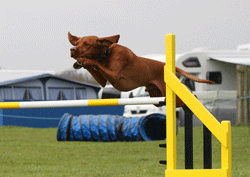
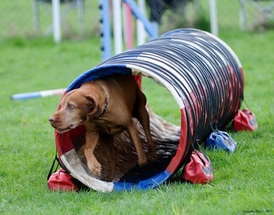
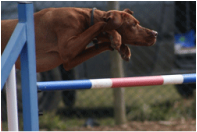
Dog Agility – What is it? How do I get involved?
History
Dog Agility is a relatively new sport that started in the early 1980s. It consists of a handler directing a dog through an obstacle course designed by the Judge in a race for both time and accuracy. Dogs run off the lead with no food or toys as incentives and the handler is not allowed to touch either the dog or the obstacles. Faults are incurred for all errors and for exceeding the course time and some errors will result in elimination. The winner is the fastest clear round.
If you do not want to compete, there is still no reason why you cannot train your dog, most clubs will have a mix of competing and non-competing members. However, be aware that a lot of handlers started out doing it just for fun!
What do I need to do first?
Because you don’t want to damage your new puppy, start training to basic commands. Try to get a good “wait” and “sit” commands, a good recall will be helpful as well. Socialise your puppy with other dogs and people and try to get him to focus on you. You can reward with treats, toys or clicker training. When your pup is of an age (6 – 12 months), start searching for a good club local to you. Lists of clubs can be found on the and on the Agilitynet website, go and visit (without your dog) and decide which one would suit you and your dog best and book for the beginners class. The only way to find out if you and your dog will enjoy this sport is to give it a go!
Who runs competitions and what classes are there?
Your training club will probably offer club competitions – these are fun events but there are plenty of other alternatives listed below.
Competitors and their dogs come in all shapes, sizes and ages – I have even seen a lady compete using a mobility scooter, so please don’t think that the only physique possible is that of an Olympic Athlete. You don’t have to be a superstar or have a perfect dog to enter these events, everyone has to start somewhere and there are always dogs and handlers, at every level of competition, who don’t get it exactly right on the night! One way of getting competition experience without the stress is to enter NFC (Not For Competition) or “Anysize” depending on who is running the show. You can enter a class, but are not judged, and can take a training toy (but not treats) to encourage your dog. You may also find classes for “Veteran” (over 7 years) dogs so they needn’t miss out either.
Before you enter either a KC or UKA competition, you have to have your dog measured so they can enter the correct height classes. Ask at your training club for details of the next measuring session.
Competition dates and venues can be found online, HERE or HERE and HERE, you can either enter by post or online – the diary will tell you if you can do either or. The closing date for entries is usually about a month before the date of the show, so keep an eye on the diaries and if you’re not sure which is the best show to enter for you – ask your trainer.
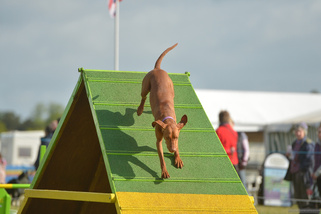
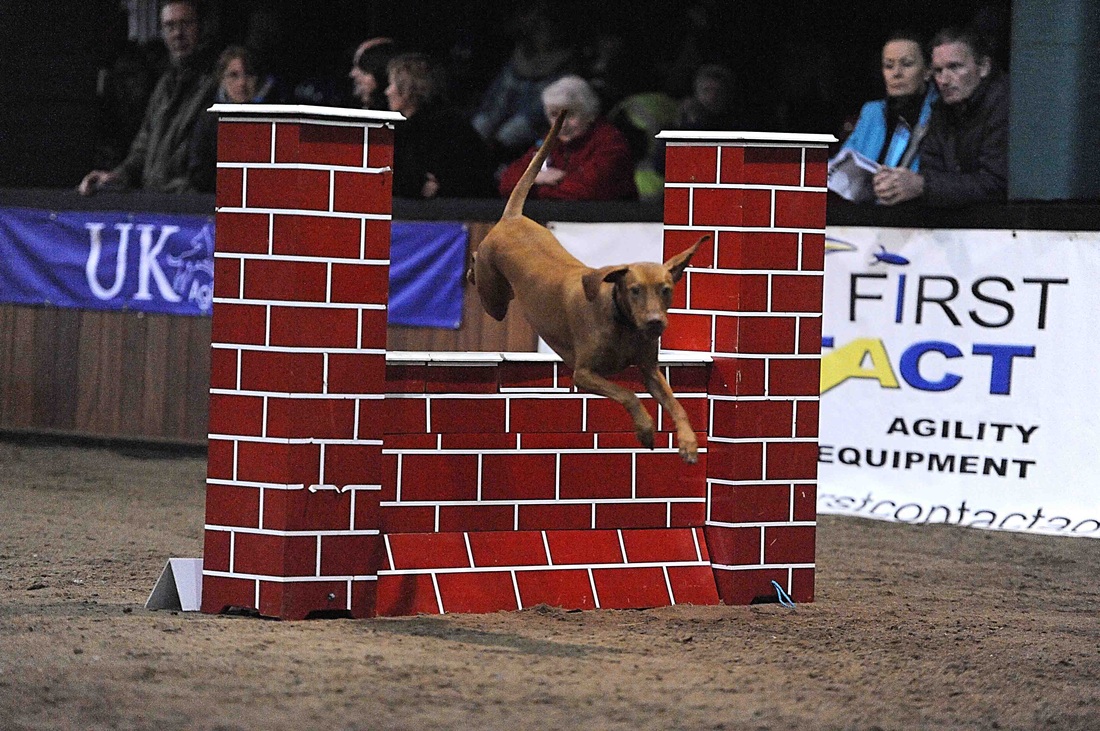

The Kennel Club
All dogs must be over 18 months of age or over and fit to take part when entering a competition, as it is such a physical sport and so much training is necessary before a dog can compete.
Types of Agility Show Agility Matches are restricted to members of the show society only.
Limited Agility Shows are restricted to members of the show society, or competitors from a certain area, or, limited to certain breeds, or, numbers of class entries, overall numbers of entries or other limited agreed by the Kennel Club. Limited agility shows may have 3 standard progression classes.
Open Agility Shows are just that, open to all who wish to take part and may cap the total number of dogs in a class (the minimum cap/limit is 250 dogs).
Premier Shows are those that hold Kennel Club qualifiers for Crufts, Discover Dogs or Olympia. They will also have standard qualifying classes.
Championship Agility Shows hold a special Championship Class which is divided into three separate rounds. The winner and 2nd placed dogs being awarded an Agility Certificate and a Reserve Agility Certificate.
Classes
Agility classes feature ‘Jumping’ courses and ‘Agility’ courses. Each course features a variety of Agility obstacles. However, jumping courses do not require the dogs to undertake the see-saw, dog walk or ‘A’ ramp obstacles. (To see all the obstacles that may be included go to the KC website by clicking HERE.
An Agility competitor and their dog advance from Grades 1 – 7, Grade 1 is the lowest level and Grade 7 the highest level. Competitors and dogs that are new to Agility will be able to enter classes suitable for Grade 1. As you and your dog improve you may be able to progress to the next Grade. There are two ways in which a competitor can progress, the first is progression on wins and the second is through points progression.
Other classes that are scheduled at an Agility Show may fall under the title of “Special classes.” Special classes are classes where the definition for eligibility to compete is not per Kennel Club Regulations, the marking of the class differs from standard Kennel Club marking or the course design is non-standard.
Classes such as these, with unusual names like Helter Skelter, Gamblers, Time, Fault and Out, Power and Speed, ABC – Anything But A Collie, Any Sized and Pairs, will be clearly defined in the schedule along with details of eligibility, so you know exactly what to expect when you enter the class. It should be noted that you cannot claim points or progress from Special classes.
(source The Kennel Club)
UK Agility
UKA supports two Programmes, The Performance Programme, where the minimum age of the dog should be 18 months and The Steeplechase Programme where the minimum age of the dog should be 16 months, which enable dogs to progress up the levels of the Programmes by gathering the required total of points set per level. Points are awarded on the basis of wins and class placements that are qualifying rounds. Points are also awarded for clear rounds that are not placed. No points will be received for placements with time or course faults.
Agility
The object of this class is to negotiate a full course of agility equipment with a minimum of 17 obstacles to a maximum of 20 obstacles. All obstacles must be performed in order and direction defined by number. The numbers should be placed on the side of the obstacle to designate the direction the obstacle should be taken. If a number is placed in the middle of an obstacle such as a curved tunnel, the obstacle may be taken in either direction.
The class must include the dog-walk, A-frame, see-saw, and a set of weave poles and may also include a table, unless unsatisfactory conditions cause the use of any obstacle to be unsafe. Beginner’s level can have a maximum of 12 weave poles.
In order to receive a clear round/qualifying score (Q), the dog must run the course under standard course time (SCT) and have not been faulted.
Jumping
The object of this class is to negotiate a course, without contact equipment, with a minimum of 17 obstacles and a maximum of 20 obstacles. All obstacles must be performed in order and direction defined by number. The numbers should be placed on the side of the obstacle to designate the direction the obstacle should be taken. If a number is placed in the middle of an obstacle such as a curved tunnel, the obstacle may be taken in either direction.
The class can include all equipment with the exception of the 3 contacts and table. A set of weave poles must be included unless unsatisfactory conditions cause the use of the obstacle to be unsafe. In the Champion level the number of weave poles must be a single set of 12 poles unless unsatisfactory conditions cause the use of the obstacle to be unsafe. Beginner’s level can have a maximum of 12 weave poles.
In order to receive a clear round/qualifying score (Q), the dog must run the course under standard course time (SCT) and have not been faulted.
Steeplechase
Dogs must be at least 16 calendar months of age to compete in this class, as opposed to the Performance classes where it is 18 months. The object of this class is to negotiate a course made up with only jumps (excluding the tyre, spreads, walls and long jump) and tunnels (excluding collapsible tunnels), with a minimum of 17 obstacles and a maximum of 20 obstacles. The course should be a fast and straight forward set up. All obstacles must be performed in order and direction defined by number. The numbers should be placed on the side of the obstacle to designate the direction the obstacle should be taken. If a number is placed in the middle of an obstacle such as a curved tunnel, the obstacle may be taken in either direction.
In order to receive a clear round/qualifying score (Q), the dog must run the course under standard course time (SCT) and have not been faulted.
Games Classes
UKA competitions may contain one or more of the following games. Games are designed to test the handler and dog in dealing with the different elements of course strategy, distance control, and versatility. Qualifying rounds from the following games, will meet the necessary games’ requirements to achieve Level points in the Performance Program: Gamblers, Snooker, Power & Speed, Snakes & Ladders and Time Fault & Out. Full details of the Games classes can be found on the UKA website under Rules.
(Source UK Agility Rules)
Independent Shows
These are normally run by small training clubs and will contain similar classes to those mentioned above, but tend to be smaller and more informal. Great for confidence building for both you and your dog.
Don’t forget the UK HV & HWV Agility League group on Facebook – a great source of knowledge and support, they run an annual competition just for Vizzies (and honorary Vizzies).
Help! I’ve entered my first show!!
Congratulations! Don’t panic! Have fun!
Before you go:
You will have been sent (or downloaded) your ring plan and running order. Now get the calculator out so you can work out roughly what time you will be running by allowing 1 minute for each competitor before you. Prepare a “show bag” containing your treats, toys, leads, water bowls, water, pooh bags etc.
Things to take with you:
Sense of humour, dog, directions, paperwork, pen, lunch, flask, fold up chairs, suitable clothing for the great British weather, show bag (see above), friend or partner to give moral support and to hold the dog while you walk the course (you can leave them in the car!), money for trade stands, a clear small plastic bag to put your running order and ring plan in if its raining.
- Remember
- You can’t take toys or treats into the ring (unless NFC – see above) so leave your stuff eg bum bag, treat bag, whistle etc, outside the ring with the ring steward.
- The dog can run with a flat collar (with no dangly tags or half checks) or no collar – its up to you.
- Be careful if the ground is damp – smooth trainers will slip on wet grass – invest in some with a good tread.
- No flappy clothes that can obscure your body language/hand signals.
- Give yourself plenty of time to get there and orientate yourself – find the rings you will be running in, the loos, the refreshment tent and the trade stands.
- Keep an eye on the boards at the entrance to each ring, they will tell you which class is currently running.
- You will be allowed to walk the course, without your dog, before your class starts, take this opportunity to walk it as often as you wish, deciding which is going to be the best way round for you. Don’t listen to the other competitors as they aren’t running your dog!
- If you have time, watch some people running in the same class as you to see how they do, it will help you memorise the course and re-enforce any tricky sections that need to be tackled (an extra shout might just avoid a penalty!).
- Try to make sure your dog has emptied before running the course (its amazing how jumping promotes the need to wee (or worse!) and that will lead to being eliminated.
- The ring steward should tell you what numbers they are calling to queue, when you get to the head of the queue, you will be asked for your number, then its time to get on the start line!
- Set up your dog and wait for the scrivener (the person on the timing box) to say its ok to start – take a deep breath, relax, run and enjoy!!!!!
- If it all goes completely pear-shaped and you decide not to finish the course, do try to get your dog over the last jump so it stops the timer (or wave your arm over it if the dog is not co-operating!).
- When you’ve finished your round, do thank the judge as you leave the ring.
- If in doubt about anything – find someone to ask! Because they will help.